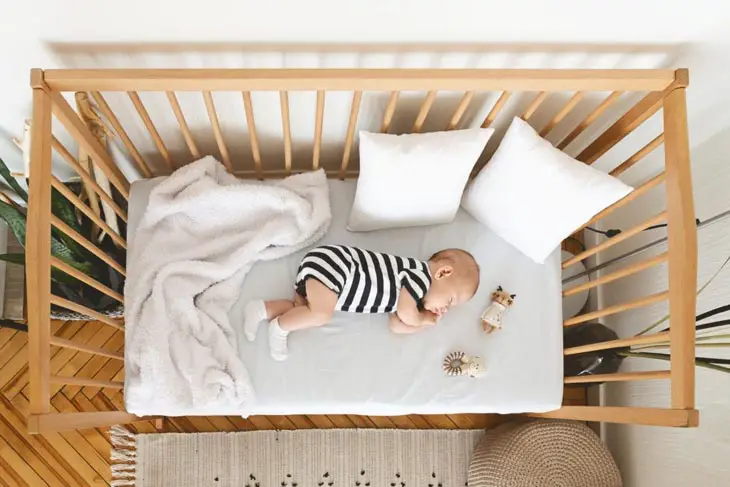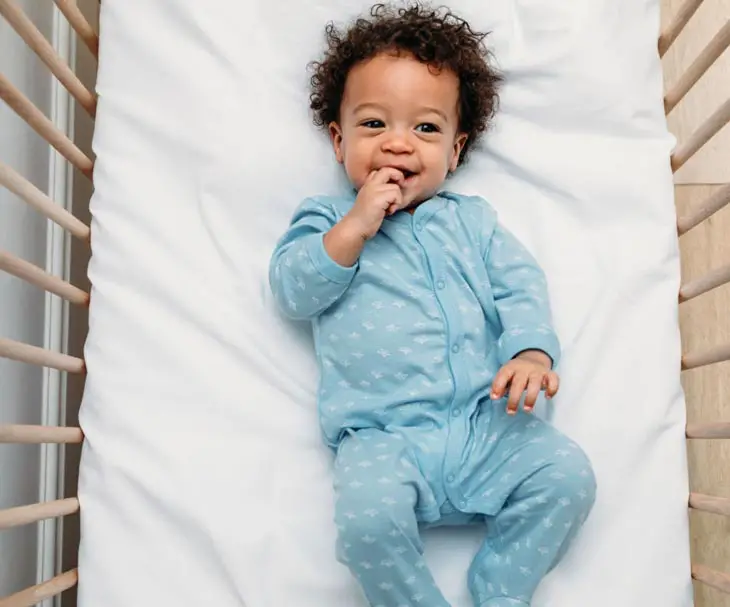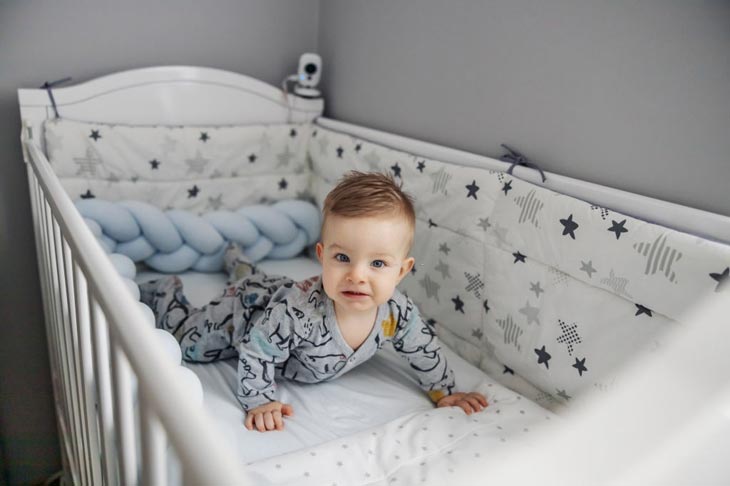Many parents want their infant to sleep in a bassinet, which is practical due to its size and portability.
However, not all newborns develop at the same rate. As a result, determining when is baby too big for bassinet is difficult.
But, the following article will lead you through all you need to know about when to move baby out of bassinet to another sleeping location.
When Is Baby Too Big For Bassinet? 5 Important Signs
1. Don’t Have Enough Space

Your younger child will grow out of the item before you realize it. Your little one may slither diagonally and seem squashed when sleeping, forcing them to sleep in an uncomfortable posture.
When does a baby outgrow a bassinet? By three or four months, most newborns are ready to move into a larger sleeping space.
When your baby moves to side of bassinet, or they can roll over, sit up. It’s no longer safe for little angels to sleep in this item because they may easily flip it over or fall out.
2. Milestones or Movement

If your baby rotates in bassinet, they should no longer be sleeping in this item. If you see a full rollover (from back to front or front to back) during playing, you should get them out and into the crib immediately away.
When a baby moving in bassinet (they sit up on their own or pull themselves up from a laying down to a sitting or standing posture), you should discontinue utilizing this item.
These appliances feature low walls and are designed for newborns who only sleep on their backs. Bassinet nights are ended if you see any of these milestones during the day.
If you are too busy and still don’t have a new bassinet (crib) yet, leave your little ones with grandparents to babysit them.
3. Safety

Bassinets are one of the safest places to put your little monsters down for a nap or sleep during the day.
But keep in mind that they are nearly always made for small infants who don’t move much and sleep on their backs.
Before deciding on and purchasing it, be sure to review and compare all of the specs of the models you’re considering.
You might not need the biggest bassinet that can hold up to 30 pounds if you already have a second sleeping option for your little one.
Check any warning labels and place the item on a firm, level ground with plenty of view and ventilation.
4. The Weight Limits

Like every other item used by newborns, bassinets have a weight restriction. The loading capacity of each item is different.
How much weight can a bassinet hold? Some have a 15-pound weight limit, while other items can weigh up to 30 pounds. As a result, double-check the weight limit.
It’s time to acquire your little angel something different, like a younger child crib, if they have outgrown the advised weight limit for bassinet. If you don’t, you’re putting your infants’ health in danger.
It’s also critical to monitor your child’s weight. After reaching the co-sleeper weight limit, it’s time to put your infant in a crib or new sleeping arrangement.
5. Baby Hates Being In The Bassinet

Babies don’t always enjoy this item. The majority of the time, it’s because they’ve grown too large for the place they’re in.
Consider moving to a different sleeping arrangement if your little one becomes unhappy when placing them in this item.
There are a few more symptoms that your infant doesn’t like in their bassinet. When they wake up in the middle of the night, you’ll find that it’s becoming more difficult to get them back to sleep.
However, before you change your infants’ sleeping position, check sure this is the source of their irritability. Keep a sharp eye on their behavior for any changes.
If babies exclusively scream or act squirmy in their co-sleeper and not in other locations, it’s time to change it.
Why Are Bassinets So Popular Despite Their Short Lifespan?
The bassinet ages are short. It depends on the weight limit of this item and your little angel’s development. But why is it so popular and used so much?
Large cribs or anything else that easily fits in the nursery can barely fit in one bedroom. Even though the younger child outgrows it soon, this is one of the main reasons parents prefer them.
The cost is another important factor to consider. In comparison to other possibilities, bassinets are quite inexpensive. They also don’t take up many areas in the main bedroom.
These are also highly stylish when paired with other pieces of furniture. Parents may keep their children in their room without disrupting the decor.
When To Stop Using Bassinet?

When to stop using halo bassinest? If you’re using this item for the following reasons, you should quit.
- Your child has exceeded the weight limit.
- In this item, you realize your little angel is becoming restless.
- Your children have demonstrated that he can roll over on his own.
- Baby too long for bassinet.
- Your children can pull themselves up to a sitting or standing posture.
It’s time to put it away if you experience any of these symptoms.
What To Do When Baby Outgrows Bassinet But Not Ready For The Crib?
If your baby too big for bassinet but not ready for crib, don’t hesitate growing bassinet to a larger one.
Newborns must rest alone in a four-sided sleeping area with mesh fabric on both sides for ventilation, strong bars under the baby’s head, and an inflating mattress. This way, they don’t hang off while sleeping down.
In terms of safety features, this item is comparable to a crib, and every bassinet marketed must comply with rigorous Consumer Product Safety Commission rules.
Don’t forget about the extra safety measures that make it a secure sanctuary for babies:
- Height-adjustable features
- Folding features
- Extra storage spaces
- Lockable wheels
- The slidable base makes it easy to store beneath any bed.
In short, for the children outgrows the item and unprepared use crib. Parents can upgrade it or buy the Graco 4 in 1 bassinet (designed to adapt to your growing child from newborn to toddler).
Related Questions
Q1: Is it safe to let your baby sleep on a swing?
Swings are well-known for lulling babies to sleep, but they aren’t suitable for nighttime sleep or even napping.
It’s fine to use a swing when the infant is awake and supervised, but it’s risky when the baby falls asleep in this one.
When a little one is napping in a swing, one risk is that their head may droop forward, obstructing their airway (a condition known as positional asphyxiation).
Other risks include your infant suffocating against the soft cushioning, becoming caught in the straps, or rolling over in the swing. (Even when parents utilize the straps correctly, the younger child can still roll.)
Q2: What should I do if my baby wakes up when I place them in their bassinet?
First, it’s crucial to recognize that a baby’s sleep pattern differs from that of an adult.
According to a report published by the Washington State Department of Health, babies fall asleep deeply after about 20 – 30 minutes. This implies that if your kid is awakened before this time, they will readily wake up.
It’s possible that you tried to put your baby down too soon, which contributed to the problem.
Furthermore, newborns who can’t put themselves to sleep due to a lack of self-soothing abilities may frequently wake up, especially during naps or at night. It’s because they rely on a “prop” to sleep.
A bottle, breast, pacifier, rocking, or big co-sleeper (mom and dad) can all be used as a prop, implying that this is the primary reason your infant wakes up when you put them down.
Conclusion
When it comes to infant care, parents frequently have many questions regarding their child’s growth, such as “When is baby too big for bassinet“.
However, everyone can agree that there are no formal parenting norms. There are several differences between each infant. As a result, there’s no one-size-fits-all answer to those questions.
Keep an eye on your baby’s weight, demeanor, and mobility, and you should be able to feel. Hope you found the preceding information useful.
